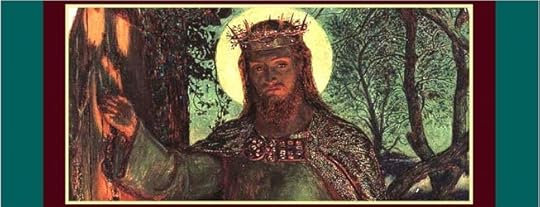Carl E. Olson's Blog, page 115
January 3, 2014
“The Best Books I Read in 2013”
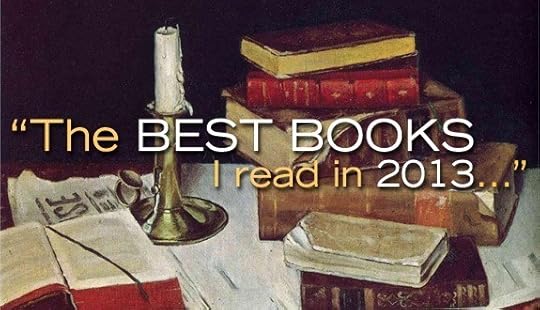
“The Best Books I Read in 2013” | CWR Staff and Guests
Featuring contributions from Dana Gioia, Anthony Esolen, Thomas Howard, Michael Coren, Joseph Pearce, James V. Schall, Brandon Vogt, and many more.
“Everywhere have I sought rest and found it not, except sitting apart in a nook with a little book.” — Thomas a Kempis
Our first “Best Books I Read in…” compilation appeared nine years ago on Ignatius Insight and it has grown in both popularity and length each year. This year we have nearly 40 entries (if my blurry vision can be trusted), all from CWR contributors, editors, and friends, each of whom was asked to respond to the simple question, “What were the best books you read in the past year?” The books chosen did not have to be published in 2013, nor did they have to be about a specific topic. So, pull up a chair—or find a nook—and prepare to discover a few new books. — Carl E. Olson, editor
January 1, 2014
"Hail, Full of Grace": Mary, the Mother of Believers

"Hail, Full of Grace": Mary, the Mother of Believers | Joseph Cardinal Ratzinger | An excerpt from Mary: The Church at the Source
"From henceforth all generations will call me blessed"–these words of the Mother of Jesus handed on for us by Luke (Lk 1:48) are at once a prophecy and a charge laid upon the Church of all times. This phrase from the Magnificat, the spirit-filled prayer of praise that Mary addresses to the living God, is thus one of the principal foundations of Christian devotion to her.
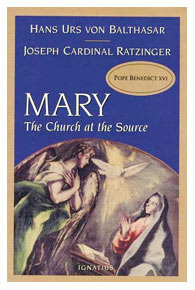 The Church invented nothing new of her own when she began to extol Mary; she did not plummet from the worship of the one God to the praise of man. The Church does what she must; she carries out the task assigned her from the beginning. At the time Luke was writing this text, the second generation of Christianity had already arrived, and the "family" of the Jews had been joined by that of the Gentiles, who had been incorporated into the Church of Jesus Christ. The expression "all generations, all families" was beginning to be filled with historical reality. The Evangelist would certainly not have transmitted Mary's prophecy if it had seemed to him an indifferent or obsolete item. He wished in his Gospel to record "with care" what "the eyewitnesses and ministers of the word" (Lk 1:2-3) had handed on from the beginning, in order to give the faith of Christianity, which was then striding onto the stage of world history, a reliable guide for its future course.
The Church invented nothing new of her own when she began to extol Mary; she did not plummet from the worship of the one God to the praise of man. The Church does what she must; she carries out the task assigned her from the beginning. At the time Luke was writing this text, the second generation of Christianity had already arrived, and the "family" of the Jews had been joined by that of the Gentiles, who had been incorporated into the Church of Jesus Christ. The expression "all generations, all families" was beginning to be filled with historical reality. The Evangelist would certainly not have transmitted Mary's prophecy if it had seemed to him an indifferent or obsolete item. He wished in his Gospel to record "with care" what "the eyewitnesses and ministers of the word" (Lk 1:2-3) had handed on from the beginning, in order to give the faith of Christianity, which was then striding onto the stage of world history, a reliable guide for its future course.
Mary's prophecy numbered among those elements he had "carefully" ascertained and considered important enough to transmit to posterity. This fact assumes that Mary's words were guaranteed by reality: the first two chapters of Luke's Gospel give evidence of a sphere of tradition in which the remembrance of Mary was cultivated and the Mother of the Lord was loved and praised. They presuppose that the still somewhat naive exclamation of the unnamed woman, "blessed is the womb that bore you" (Lk 11:27), had not entirely ceased to resound but, as Jesus was more deeply understood, had likewise attained a purer form that more adequately expressed its content. They presuppose that Elizabeth's greeting, "blessed are you among women" (Lk 1:42), which Luke characterizes as words spoken in the Holy Spirit (Lk 1:4 1), had not been a once-only episode.
The continued existence of such praise at least in one strand of early Christian tradition is the basis of Luke's infancy narrative. The recording of these words in the Gospel raises this veneration of Mary from historical fact to a commission laid upon the Church of all places and all times.
The Church neglects one of the duties enjoined upon her when she does not praise Mary. She deviates from the word of the Bible when her Marian devotion falls silent. When this happens, in fact, the Church no longer even glorifies God as she ought. For though we do know God by means of his creation–"Ever since the creation of the world [God's] invisible nature, namely, his eternal power and deity, has been clearly perceived in the things that have been made" (Rom 1:20)–we also know him, and know him more intimately, through the history he has shared with man. just as the history of a man's life and the relationships he has formed reveal, what kind of person he is, God shows himself in a history, in men through whom his own character can be seen.
This is so true that he can be "named" through them and identified in them: the God of Abraham, of Isaac, and of Jacob. Through his relation with men, through the faces of men, God has made himself accessible and has shown his face. We cannot try to bypass these human faces in order to get to God alone, in his "pure form", as it were. This would lead us to a God of our own invention in. place of the real God; it would be an arrogant purism that regards its own ideas as more important than God's deeds. The above cited verse of the Magnificat shows us that Mary is one of the human beings who in an altogether special way belong to the name of God, so much so, in fact, that we cannot praise him rightly if we leave her out of account.
In doing so we forget something about him that must not be forgotten. What, exactly? Our first attempt at an answer could be his maternal side, which reveals itself more purely and more directly in the Son's Mother than anywhere else. But this is, of course, much too general. In order to praise Mary correctly and thus to glorify God correctly, we must listen to all that Scripture and tradition say concerning the Mother of the Lord and ponder it in our hearts. Thanks to the praise of "all generations" since the beginning, the abundant wealth of Mariology has become almost too vast to survey. In this brief meditation, I would like to help the reader reflect anew on just a few of the key words Saint Luke has placed in our hands in his inexhaustibly rich infancy narrative.
Mary, Daughter Zion–Mother of Believers
Let us begin with the angel's greeting to Mary. For Luke, this is the primordial cell of Mariology that God himself wished to present to us through his messenger, the Archangel Gabriel.
Translated literally, the greeting reads thus: "Rejoice, full of grace. The Lord is with you" (Lk 1:28). "Rejoice": At first sight, this word appears to be no more than the formulaic greeting current in the Greek-speaking world, and tradition has consistently translated it as "hail". But looked at against the background of the Old Testament, this formula of greeting takes on a more profound significance. Consider, in fact, that the same word used by Luke appears four times in the Septuagint, where in each case it is an announcement of messianic joy (Zeph 3:14; Joel 2:21; Zech 9:9; Lam 4:21).
This greeting marks the beginning of the Gospel in the strict sense; its first word is "joy", the new joy that comes from God and breaks through the world's ancient and interminable sadness. Mary is not merely greeted in some vague or indifferent way; that God greets her and, in her, greets expectant Israel and all of humanity is an invitation to rejoice from the innermost depth of our being. The reason for our sadness is the futility of our love, the overwhelming power of finitude, death, suffering, and falsehood. We are sad because we are left alone in a contradictory world where enigmatic signals of divine goodness pierce through the cracks yet are thrown in doubt by a power of darkness that is either God's responsibility or manifests his impotence.


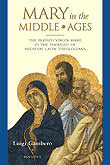


 "Rejoice"–what reason does Mary have to rejoice in such a world? The answer is: "The Lord is with you." In order to grasp the sense of this announcement, we must return once more to the Old Testament texts upon which it is based, in particular to Zephaniah. These texts invariably contain a double promise to the personification of Israel, daughter Zion: God will come to save, and he will come to dwell in her. The angel's dialogue with Mary reprises this promise and in so doing makes it concrete in two ways. What in the prophecy is said to daughter Zion is now directed to Mary: She is identified with daughter Zion, she is daughter Zion in person.
"Rejoice"–what reason does Mary have to rejoice in such a world? The answer is: "The Lord is with you." In order to grasp the sense of this announcement, we must return once more to the Old Testament texts upon which it is based, in particular to Zephaniah. These texts invariably contain a double promise to the personification of Israel, daughter Zion: God will come to save, and he will come to dwell in her. The angel's dialogue with Mary reprises this promise and in so doing makes it concrete in two ways. What in the prophecy is said to daughter Zion is now directed to Mary: She is identified with daughter Zion, she is daughter Zion in person. In a parallel manner, Jesus, whom Mary is permitted to bear, is identified with Yahweh, the living God. When Jesus comes, it is God himself who comes to dwell in her. He is the Savior–this is the meaning of the name Jesus, which thus becomes clear from the heart of the promise. René Laurentin has shown through painstaking textual analyses how Luke has used subtle word play to deepen the theme of God's indwelling. Even early traditions portray God as dwelling "in the womb" of Israel–in the Ark of the Covenant. This dwelling "in the womb" of Israel now becomes quite literally real in the Virgin of Nazareth. Mary herself thus becomes the true Ark of the Covenant in Israel, so that the symbol of the Ark gathers an incredibly realistic force: God in the flesh of a human being, which flesh now becomes his dwelling place in the midst of creation.
The angel's greeting–the center of Mariology not invented by the human mind–has led us to the theological foundation of this Mariology. Mary is identified with daughter Zion, with the bridal people of God. Everything said about the ecclesia in the Bible is true of her, and vice versa: the Church learns concretely what she is and is meant to be by looking at Mary. Mary is her mirror, the pure measure of her being, because Mary is wholly within the measure of Christ and of God, is through and through his habitation. And what other reason could the ecclesia have for existing than to become a dwelling for God in the world? God does not deal with abstractions. He is a person, and the Church is a person. The more that each one of us becomes a person, person in the sense of a fit habitation for God, daughter Zion, the more we become one, the more we are the Church, and the more the Church is herself.
The typological identification of Mary and Zion leads us, then, into the depths. This manner of connecting the Old and New Testaments is much more than an interesting historical construction by means of which the Evangelist links promise and fulfillment and reinterprets the Old Testament in the light of what has happened in Christ. Mary is Zion in person, which means that her life wholly embodies what is meant by "Zion". She does not construct a self-enclosed individuality whose principal concern is the originality of its own ego. She does not wish to be just this one human being who defends and protects her own ego. She does not regard life as a stock of goods of which everyone wants to get as much as possible for himself.
Her life is such that she is transparent to God, "habitable" for him. Her life is such that she is a place for God. Her life sinks her into the common measure of sacred history, so that what appears in her is, not the narrow and constricted ego of an isolated individual, but the whole, true Israel. This "typological identification" is a spiritual reality; it is life lived out of the spirit of Sacred Scripture; it is rootedness in the faith of the Fathers and at the same time expansion into the height and breadth of the coming promises. We understand why the Bible time and again compares the just man to the tree whose roots drink from the living waters of eternity and whose crown catches and synthesizes the light of heaven.
Let us return once more to the angel's greeting. Mary is called "full of grace". The Greek word for grace (charis) derives from the same root as the words joy and rejoice (chara, chairein). Thus, we see once more in a different form the same context to which we were led by our earlier comparison with the Old Testament. Joy comes from grace. One who is in the state of grace can rejoice with deep-going, constant joy. By the same token, grace is joy.
What is grace? This question thrusts itself upon our text. Our religious mentality has reified this concept much too much; it regards grace as a supernatural something we carry about in our soul. And since we perceive very little of it, or nothing at all, it has gradually become irrelevant to us, an empty word belonging to Christian jargon, which seems to have lost any relationship to the lived reality of our everyday life. In reality, grace is a relational term: it does not predicate something about an I, but something about a connection between I and Thou, between God and man. "Full of grace" could therefore also be translated as: "You are full of the Holy Spirit; your life is intimately connected with God." Peter Lombard, the author of what was the universal theological manual for approximately three centuries during the Middle Ages, propounded the thesis that grace and love are identical but that love "is the Holy Spirit".
Grace in the proper and deepest sense of the word is not some thing that comes from God; it is God himself. Redemption means that God, acting as God truly does, gives us nothing less than himself The gift of God is God–he who as the Holy Spirit is communion with us. "Full of grace" therefore means, once again, that Mary is a wholly open human being, one who has opened herself entirely, one who has placed herself in God's hands boldly, limitlessly, and without fear for her own fate. It means that she lives wholly by and in relation to God. She is a listener and a prayer, whose mind and soul are alive to the manifold ways in which the living God quietly calls to her. She is one who prays and stretches forth wholly to meet God; she is therefore a lover, who has the breadth and magnanimity of true love, but who has also its unerring powers of discernment and its readiness to suffer.
Luke has flooded this fact with the light of yet another round of motifs. In his subtle way he constructs a parallel between Abraham, the father of believers, and Mary, the mother of believers. To be in a state of grace means: to be a believer. Faith includes steadfastness, confidence, and devotion, but also obscurity. When man's relation to God, the soul's open availability for him, is characterized as "faith", this word expresses the fact that the infinite distance between Creator and creature is not blurred in the relation of the human I to the divine Thou. It means that the model of "partnership", which has become so dear to us, breaks down when it comes to God, because it cannot sufficiently express the majesty of God and the hiddenness of his working. It is precisely the man who has been opened up entirely into God who comes to accept God's otherness and the hiddenness of his will, which can pierce our will like a sword.
The parallel between Mary and Abraham begins in the joy of the promised son but continues apace until the dark hour when she must ascend Mount Moriah, that is, until the Crucifixion of Christ. Yet it does not end there; it also extends to the miracle of Isaac's rescue-the Resurrection of Jesus Christ. Abraham, father of faith-this title describes the unique position of the patriarch in the piety of Israel and in the faith of the Church. But is it not wonderful that-without any revocation of the special status of Abraham–a "mother of believers" now stands at the beginning of the new people and that our faith again and again receives from her pure and high image its measure and its path?
[Excerpted from the chapter "'Hail, Full of Grace': Elements of Marian Piety According to the Bible", from Mary: The Church at the Source by Joseph Cardinal Ratzinger and Hans Urs von Balthasar, pp. 61-69. Footnotes have been omitted.]
The Blessed Virgin in the History of Christianity

The Blessed Virgin in the History of Christianity | John A. Hardon, S.J.
Christianity would be meaningless without the Blessed Virgin. Her quiet presence opened Christian history at the Incarnation and will continue to pervade the Church's history until the end of time.
Our purpose in this meditation is to glance over the past two thousand years to answer one question: What are the highlights of our Marian faith as found in the Bible and the teaching of the Catholic Church?
New Testament
The first three evangelists were mainly concerned with tracing Christ's ancestry as Son of Man and, therefore, as Son of Mary. St. Matthew, writing for the Jews, stressed Christ's descent from Abraham. St. Luke, disciple of St. Paul, traced Christ's origin to Adam, the father of the human race. Yet both writers were at pains to point out that Mary's Son fulfilled the prophecy of Isaiah about the Messiah. He was to be born of a virgin to become Emmanuel, which means "God with us." Luke gave a long account of the angel's visit to Mary to announce that the Child would be holy and would be called the "Son of God" (Luke 1:36).
St. John followed the same pattern. He introduced Mary as the Mother of Jesus when He began His public ministry. In answer to her wishes, Christ performed the miracle of changing water into wine at the wedding feast in Cana in Galilee. What happened then has continued ever since. Most of the miraculous shrines of Christianity have been dedicated to Our Lady.
It is also St. John who tells us that Mary stood under the Cross of Calvary as her Son was dying for our salvation. Speaking of John, Jesus told His Mother, "This is your son." To John, He said of Mary, "This is your Mother." The apostle John represented all of us. On Good Friday, therefore, Christ made His Mother the supernatural Mother of the human race and made us her spiritual children.
Mother of God
In the early fifth century, a controversy arose in Asia Minor, where the Bishop of Constantinople claimed that Mary was only the Mother of Christ (Greek=Christotokos). He was condemned by the Council of Ephesus in 431, which declared that "the holy Virgin is the Mother of God (Greek=Theotokos).
St. Cyril, Bishop of Alexandria in Egypt, was mainly responsible for this solemn definition of Mary's divine maternity. It was St. Cyril who thus composed the most famous Marian hymn of antiquity. It is a praise of Our Lady as Mediatrix with God:
Through you, the Trinity is glorified.
Through you, the Cross is venerated throughout the world.
Through you, angels and archangels rejoice.
Through you, the demons are driven away.
Through you, the fallen creature is raised to heaven.
Through you, the churches are founded in the whole world.
Through you, people are led to conversion.
Every other title of Mary and all the Marian devotion of the faithful are finally based on the Blessed Virgin's primary claim to our extraordinary love. She is the Mother of God. She gave her Son all that every human mother gives the child she conceives and gives birth to. She gave Him His human body. Without her, there would have been no Incarnation, no Redemption, no Eucharist; in a word, no Christianity.
Mary's Virginity
Logically related to her divine maternity is Our Lady's perpetual virginity. From the earliest days the Church has taught that Mary was a virgin before giving birth to Jesus, in giving His birth, and after His birth in Bethlehem.
All of this is already stated or implied in the Gospels. In St. Matthew's genealogy of Jesus, all the previous ancestors are called "father." But then we are told there came "Joseph, the husband of Mary of whom Jesus was born, who is called the Christ" (Matthew 1:16). St. Luke twice identifies Mary as "virgin," who "knows not man."
Already in the early Church, those who questioned Christ's divinity were the same ones who denied His Mother's virginity. As explained by St. Augustine, "When God vouchsafed to become Man, it was fitting that He should be born in this way. He who was made of her, had made her what she was: a virgin who conceives, a virgin who gives birth; a virgin with child, a virgin labored of child-a virgin ever virgin."










Given the fact of the Incarnation, its manner follows as a matter of course. Why should not the Almighty who created His Mother have also preserved the body of which He would be born? But this appropriateness of Mary's virginity makes sense only if you believe that Mary's Son is the living God.
Immaculate Conception
Mary's freedom from sin, present at her conception, is already taught by St. Ephraem in the fourth century. In one of his hymns, he addresses Our Lord, "Certainly you alone and your Mother are from every aspect completely beautiful. There is no blemish in you my Lord, and no stain in your Mother."
By the seventh century, the feast of Mary's Immaculate Conception was celebrated in the East. In the eight century, the feast was commemorated in Ireland, and from there spread to other countries in Europe.
In the twelfth and thirteenth centuries, some leading theologians, even saints, raised objections to the Immaculate Conception. Their main difficulty was how Mary could be exempt from all sin before the coming of Christ. Here the Franciscan Blessed John Duns Scotus (1266-1308) stood firm and paved the way for the definition of the Immaculate Conception by Pope Blessed Pius IX in 1854.
In the words of Pope Blessed Pius IX, "We declare, pronounce, and define that the doctrine which holds that the most Blessed Virgin Mary, in the first instant of her conception . . . was preserved from all stain of original sin, is a doctrine revealed by God and therefore to be believed firmly and constantly by all the faithful."
Four years after the definition, Our Lady appeared to St. Bernadette in Lourdes, identifying herself as the Immaculate Conception. The numerous miracles at Lourdes are a divine confirmation of the doctrine defined by Pius IX. They are also a confirmation of the papal primacy defined by the First Vatican Council under the same Bishop of Rome.
Assumption into Heaven
Not unlike his predecessor, Pope Pius XII defined Mary's bodily Assumption into heaven. On November 1, 1950, the pope responded to the all but unanimous request of the Catholic hierarchy by making a formal definition:
By the authority of our Lord Jesus Christ, of the Blessed Apostles Peter and Paul, and by our own authority, we pronounce, declare and define as divinely revealed dogma: the Immaculate Mother of God, Mary ever Virgin, after her life on earth, was assumed body and soul to the glory of heaven.
The day after the definition, Pius XII told the assembled hundreds of bishops his hope for the future: May this new honor given to Mary introduce "a spirit of penance to replace the prevalent love of pleasure and a renewal of family life stabilized where divorce was common and made fruitful where birth control was practiced." If there is one feature that characterizes the modern world, observed the Pope, it is the worship of the body. Mary's bodily Assumption into heaven reminds us of our own bodily resurrection on the last day, provided we use our bodies on earth according to the will of God.
Mother of the Church
Never in the history of Christianity has any general council spoken at such length and with such depth about Mary as the Second Vatican Council.
This is not surprising in view of the extraordinary devotion to the Blessed Virgin in our day. What the Council did was put this devotion into focus and spell out its doctrinal foundation.
First a quiet admonition. The council "charges that practices and exercises of devotion to her be treasured as recommended by the teaching authority of the Church in the course of centuries." True Marian piety consists neither in fruitless and passing emotion, nor in a certain empty credulity.
Rather authentic devotion to Mary "proceeds from true faith by which we are led to know the excellence of the Mother of God, and are moved to filial love toward our Mother and to the invitation of her virtues" (Constitution on the Church, 67-8).
What are we being told? We are told that true devotion to Our Lady is shown in a deep love of her as our Mother, put into practice by the imitation of her virtues-especially her faith, her chastity and charity.
These are the three virtues that the modern world most desperately needs.
• Like Mary, we need to believe that everything which God has revealed to us will be fulfilled.
• Like Mary, we need to use our bodily powers to serve their divine purpose no matter what the sacrifice of our own pleasure.
• Like Mary, we are to be always sensitive to the needs of others. Like her, we are to respond to these needs without being asked and, like her, even ask Jesus to work a miracle to benefit those whom we love.
No wonder the Catechism of the Catholic Church makes this astounding profession of faith: "We believe that the most holy Mother of God, the new Eve, Mother of the Church, continues in heaven her maternal role toward the members of Christ." It all depends on our faith in her maternal care and our trust in her influence over the almighty hand of her Son.
This article originally appeared in the July/August 2001 issue of The Catholic Faith magazine.
Related IgnatiusInsight.com Articles and Excerpts:
• "Hail, Full of Grace": Mary, the Mother of Believers | Joseph Cardinal Ratzinger
• Mary in Feminist Theology: Mother of God or Domesticated Goddess? | Fr. Manfred Hauke
• Excerpts from The Rosary: Chain of Hope | Fr. Benedict Groeschel, C.F.R.
• The Past Her Prelude: Marian Imagery in the Old Testament | Sandra Miesel
• Immaculate Mary, Matchless in Grace | John Saward
• The Medieval Mary | The Introduction to Mary in the Middle Ages | by Luigi Gambero
• Misgivings About Mary | Dr. James Hitchcock
• Born of the Virgin Mary | Paul Claudel
• Assumed Into Mother's Arms | Carl E. Olson
• The Disciple Contemplates the Mother | Erasmo Leiva-Merikakis
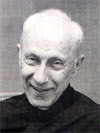 Father John Hardon, S.J. (b. June 18th, 1914 - d. December 30, 2000) was the Executive Editor of The Catholic Faith magazine. He was ordained on his 33rd birthday, June 18th, 1947 at West Baden Springs, Indiana. Father Hardon was a member of the Society of Jesus for 63 years and an ordained priest for 52 years. Father Hardon held a Masters degree in Philosophy from Loyola University and a Doctorate in Theology from Gregorian University in Rome. He taught at the Jesuit School of Theology at Loyola University in Chicago and the Institute for Advanced Studies in Catholic Doctrine at St. John's University in New York. A prolific writer, he authored over forty books, including The Catholic Catechism, Religions of the World, Protestant Churches of America, Christianity in the Twentieth Century, Theology of Prayer, The Catholic Lifetime Reading Plan, History And Theology Of Grace, With Us Today: On the Real Presence of Jesus Christ in the Eucharist, and The Treasury Of Catholic Wisdom, which he edited.
Father John Hardon, S.J. (b. June 18th, 1914 - d. December 30, 2000) was the Executive Editor of The Catholic Faith magazine. He was ordained on his 33rd birthday, June 18th, 1947 at West Baden Springs, Indiana. Father Hardon was a member of the Society of Jesus for 63 years and an ordained priest for 52 years. Father Hardon held a Masters degree in Philosophy from Loyola University and a Doctorate in Theology from Gregorian University in Rome. He taught at the Jesuit School of Theology at Loyola University in Chicago and the Institute for Advanced Studies in Catholic Doctrine at St. John's University in New York. A prolific writer, he authored over forty books, including The Catholic Catechism, Religions of the World, Protestant Churches of America, Christianity in the Twentieth Century, Theology of Prayer, The Catholic Lifetime Reading Plan, History And Theology Of Grace, With Us Today: On the Real Presence of Jesus Christ in the Eucharist, and The Treasury Of Catholic Wisdom, which he edited.
In addition, he was actively involved with a number of organizations, such as the Institute on Religious Life, Marian Catechists, Eternal Life and Inter Mirifica, which publishes his catechetical courses. For more about Fr. Hardon, visit this page at Dave Armstrong’s website.
December 30, 2013
Not a Christmas Carol

Not a Christmas Carol | K.V. Turley | CWR
The constant bustling of London often hides a dark loneliness at its core
London is a strange place, and the longer one lives in its shadows the stranger it seems to become.
Commuting home, we hardly notice those sitting or standing around us, our hands so full of newspapers and books, our heads crammed with the day’s ups and downs—some of import, most not. The last thing on anyone’s mind is the person sat opposite.
Until, that is, something extraordinary throws it all into relief.
And in this city, a few years back, that something crawled to the surface and, for a while at least, stood in full view for all to behold: proving too much for some, too little for others, and altogether too late for the unfortunate woman concerned.
This city: so full of people and things, and, yet, seemingly with such an emptiness at its core. A recent film documented this like no other I have seen. Paradoxically, it has a Festive setting; but this is definitely not A Christmas Carol, or for that matter It’s a Wonderful Life—quite the reverse in fact. There is no redemption here, and, perhaps, therein lies the reason why it still haunts me so.
Documentaries rarely make any money when shown in cinemas. One released at Christmas, dealing as it did with a lonely death, was always going to be a hard sell. And so, not surprisingly, Dreams of a Life made a pittance at the box office when released in 2011, but it did gain some impressive reviews.
The subject? A young woman who died alone in a drab apartment, remaining there for three years until the property was repossessed; by which time, her skeletal remains were waiting for the bailiffs. During those years, she had been sat in front of a television set that was still on, surrounded by recently wrapped Christmas presents. It couldn't get any more pathetic, or maybe more insightful, into an aspect of London life many would prefer not to know about. In this Christmas tale, there is to be no comforting ending: no ecstatic Scrooge, no overjoyed George Bailey reunited with his family. Instead, it is one that ends in tragedy, with an accusing finger pointing at all of us.
And yet, there is something “Dickensian” about the scene nevertheless.
December 28, 2013
The Holy Family and the Unity of God's Family
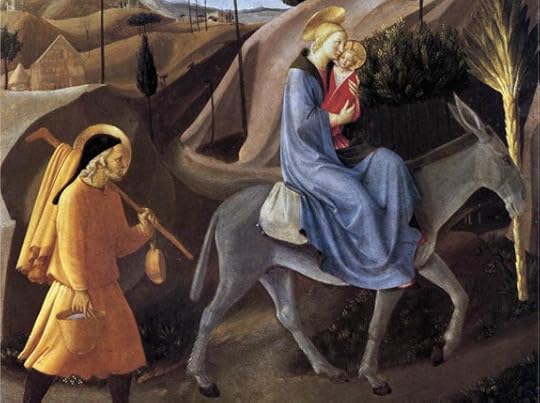
Detail of "Flight Into Egypt" by Fra Angelico (1452)
A Scriptural Reflection on the Readings for Sunday, December 29, 2013 | Feast of the Holy Family of Jesus, Mary and Joseph | Carl E. Olson
Readings:
• Sir 3:2-6, 12-14
• Ps 128:1-2, 3, 4-5
• Col 3:12-21
• Mt 2:13-15, 19-23
There’s no doubt that the family is under attack today in many ways. The list of corrupting influences and active enemies is lengthy, including adultery, divorce, “same-sex marriage,” contraceptives, and much more. Families with more than a couple of children are often mocked as being either religious zealots or simply stupid, while those who believe children are best raised by a mother and a father are regularly labeled as “narrow-minded.”
Pope John Paul II, in his 1995 encyclical, “The Gospel of Life,” noted that “human life is a gift received in order then to be given as a gift” (par 92). The family is the human communion by which life is received and love is given—and then offered to others. The family is the core of social and relational life, and without it, humanity ceases to exist. As the Second Vatican Council’s Decree on the Apostolate of the Laity stated, “This mission—to be the first and vital cell of society—the family has received from God” (par 11).
Today’s reading from Sirach reflects on the God-given nature of the family, including the specific roles of the father, mother, and children. It refers to “honor,” “authority,” “reverence,” and “obedience,” notions often ignored or even scoffed at today. Likewise, in the reading from St. Paul’s epistle to the Colossians, numerous other godly qualities are encouraged, including humility, gentleness, forgiveness, and gratitude. Yet the culture of death, so pervasive and entangling, loathes such attributes. It insists instead that relationships are about getting, not giving, and that arrogance, rudeness, and anger are acceptable when things don’t go my way.
It natural to think this state of affairs indicates that we live in a unique time, and the temptation is to look back fondly to a day the family was held in high esteem. But on this Feast of the Holy Family, I would suggest the family has been under siege from the very beginning of human history, and that the many and varied attacks on the family reveals Satan’s hatred for God’s plan of love, life, and salvation. The serpent in the Garden appealed to man’s pride, that is, to his love of self. In this way the first human family and marriage was dealt a fatal blow that has reverberated down through time.
Thanks be to God, “Christ chose to be born and grow up in the bosom of the holy family of Joseph and Mary” (Catechism of the Catholic Church, par 1655). This is not, of course, a mere historical detail, but a powerful witness to the full humanity of the Incarnate Word and to God’s love for the family. And by “the family,” I mean both the Holy Family and the family of humanity. God—as Father, Son, and Holy Spirit—is a completely perfect relationship in Himself, an eternal exchange of love. Yet in creating man, God did not only give physical life, but desired to give His own divine, Trinitarian life. “He calls together all men, scattered and divided by sin,” states the Catechism, “into the unity of his family, the Church” (CCC, 1). Through Jesus, the Son of God who became the Son of Man, the Father has formed a family, the Church, bound together by the bond and love of the Holy Spirit.
In Matthew’s account of the Holy Family fleeing to Egypt there is mention of another family—the Herodian dynasty. This powerful family of rulers was ruthless and cruel, often killing real and perceived enemies, including the innocent male babies of Bethlehem (Matt 2:16-18). Herod the Great and his sons had numerous marriages, most of which ended in divorce or execution. Likewise, many people today are willing to destroy families, including their own, in order to grasp at the temporal pleasure of life in this world. We can give thanks today that Jesus came into this world to invite us into His family, the Church, and to share in the eternal life of the Father through the divine grace of the Holy Spirit.
(This "Opening the Word" column originally appeared in the December 30, 2007, issue of Our Sunday Visitor newspaper.)
The New Saints and Blesseds of 2013
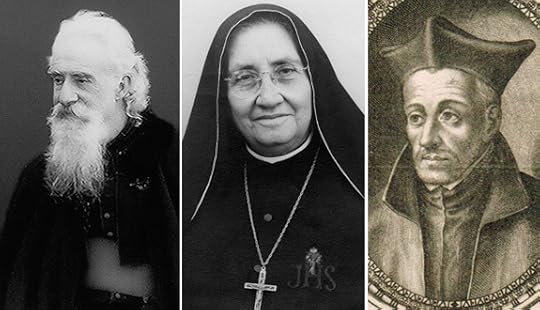
Left to right: Blessed Vladimir Ghika, Saint Maria Guadalupe Garcia Zavala, and Saint Peter Faber (CNS photos)
The New Saints and Blesseds of 2013 | J. J. Ziegler | CWR
A look at the lives of the holy men and women canonized and beatified in the last year
Blessed John Paul II is sometimes remembered as a “saint maker” who canonized 482 men and women during his 27-year pontificate. Pope Francis, however, is an even more prodigious “saint maker” who has canonized more saints than have all the popes of the past three centuries combined.
During the eighteenth century, 29 saints were canonized; between 1800 and 1903, 80 saints were canonized; and between 1903 and 1978, when Blessed John Paul II assumed the papacy, another 168 saints were canonized. Pope Benedict XVI canonized 45 saints during his eight-year pontificate. Thus 804 saints were canonized between 1700, when Clement IX assumed the papacy, and the election of Pope Francis in March 2013.
If Blessed John Paul was a “saint maker,” it was largely because of his canonizations of large groups of martyrs: 402 of the 482 saints he canonized were martyrs. And so it is with Pope Francis, who has canonized 817 saints, 813 of them martyrs.
St. Antonio Primaldo and his 812 companions were martyred by beheading in 1480 in the southeastern Italian city of Otranto, then a town of 6,000.
Two weeks before their martyrdom, 15,000 Ottoman Turks attacked the town in 140 ships; when the Spanish troops guarding the city retreated to Tuscany, the Turks began their siege. Following heroic resistance by the inhabitants, the invaders captured and plundered Otranto and killed the archbishop, priests, canons, and many lay faithful who had gathered in the cathedral. The surviving women and children were enslaved; males of age 15 or older were told they would live if they converted to Islam. A humble tailor or cobbler, St. Antonio Primaldo, spoke on behalf of them all: he said that they “confessed Jesus Christ as Son of God” and “would wish to die a thousand times rather than renounce Him and become Turks.”
“They refused to deny their faith and died professing the Risen Christ,” Pope Francis preached during the Mass of canonization. “Where did they find the strength to stay faithful? In the faith itself, which enables us to see beyond the limits of our human sight, beyond the boundaries of earthly life.”
St. Laura Montoya (1874-1949), also known as St. Laura of Saint Catherine of Siena, is the first Colombian-born canonized saint. When she was two, her father died in battle, and she grew up in poverty.
December 27, 2013
Seeing Jesus in the Gospel of John

Seeing Jesus in the Gospel of John | An Excerpt from On The Way to Jesus Christ | Joseph Cardinal Ratzinger
The farewell discourses of Jesus, as the Gospel of John presents them to us, hover in a singular way between time and eternity, between the present 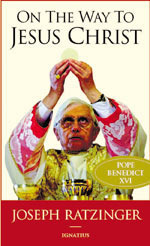 hour of the Passion and the new presence of Jesus that is already dawning, because the Passion itself is at the same time his "glorification" as well. On the one hand, the darkness of the betrayal, of the denial, of the abandonment of Jesus to the ultimate ignominy of the Cross weighs upon these discourses; in them, on the other hand, it seems that all of this has already been overcome and resolved into the glory that is to come.
hour of the Passion and the new presence of Jesus that is already dawning, because the Passion itself is at the same time his "glorification" as well. On the one hand, the darkness of the betrayal, of the denial, of the abandonment of Jesus to the ultimate ignominy of the Cross weighs upon these discourses; in them, on the other hand, it seems that all of this has already been overcome and resolved into the glory that is to come.
Thus Jesus describes his Passion as a going away that leads to a new and fuller coming–as a state of being-on-the-way with which the disciples are already acquainted.[1] Thereupon Thomas, surprised, asks the question, "Lord, we do not know where you are going; how can we know the way?" Jesus answers with a statement that has become one of the central texts of Christology: "I am the way, and the truth, and the life; no one comes to the Father, but by me."
This revelation of the Lord, however, elicits a new question now-or rather, a request, which this time is made by Philip: "Lord, show us the Father, and we shall be satisfied." Again Jesus replies with a revelatory word, which leads from another perspective into the very depths of his self-consciousness, into the very depths of the Church's faith in Christ: "He who has seen me has seen the Father" (Jn 14:2-9). The primordial human longing to see God had taken, in the Old Testament, the form of "seeking the face of God". The disciples of Jesus are men who are seeking God's face. That is why they joined up with Jesus and followed after him. Now Philip lays this longing before the Lord and receives a surprising answer, in which the novelty of the New Testament, the new thing that is coming through Christ, shines as though in crystallized form: Yes, you can see God. Whoever sees Christ sees him.
This answer, which characterizes Christianity as a religion of fulfillment, as a religion of the divine presence, nevertheless immediately evokes a new question. "Already and not yet" has been called the fundamental attitude of Christian living; what this means becomes evident precisely in this passage. For the next question is now (for all of post-apostolic Christianity, at least): How can you see Christ and see him in such a way that you see the Father at the same time?
This abiding question is placed in the Gospel of John, not in the discourses in the Cenacle, but rather in the Palm Sunday account. There it is related that some Greeks, who had made a pilgrimage to Jerusalem to worship, came to Philip–that is, to the disciple who in the Cenacle would voice the request to see the Father. These Greeks present their request to Philip, who was from Bethsaida in Galilee, an extensively Hellenized part of the Holy Land: "Sir, we wish to see Jesus"' (Jn 12:20-21). It is the request of the pagan world, but it is also the request of the Christian faithful of all times, our request: We want to see Jesus. How can that happen?

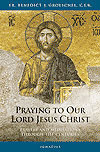


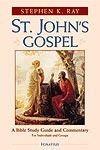

Jesus' response to this request, which was conveyed to the Lord by Philip together with Andrew, is mysterious, like most of the answers that Jesus gives in the fourth Gospel to the great questions of mankind that are posed to him. It is not recorded whether there was an actual encounter between Jesus and those Greeks. Jesus' answer, instead, opens up a horizon that is completely unexpected at this point. For Jesus sees in this request an indication that the moment of his glorification has come. He suggests in greater detail in the following words how this glorification will come about: "Unless a grain of wheat falls into the earth and dies, it remains alone; but if it dies, it bears much fruit" (Jn 12:24).
The glorification occurs in the Passion. This is what will produce "much fruit"–which is, we might add, the Church of the Gentiles, the encounter between Christ and the Greeks, who stand for the peoples of the world in general. Jesus' answer transcends the moment and reaches far into the future: Indeed, the Greeks shall see me, and not only these men who have come now to Philip, but the entire world of the Greeks. They shall see me, yes, but not in my earthly, historical life, "according to the flesh" (cf. 2 Cor 5:16 [Douay Rheims]); they will see me by and through the Passion. By and through it I am coming, and I will no longer come merely in one single geographic locality, but I will come over all geographical boundaries into the farthest reaches of the world, which wants to see the Father.
Jesus announces his coming from the perspective of his Resurrection, his coming in the power of the Holy Spirit, and so he proclaims a new way of seeing that occurs in faith. The Passion is not thereby left behind as something in the past. It is, rather, the place from which and in which alone he can be seen. Jesus expands the parable of the dying grain of wheat that is fruitful only in death into the proper and fundamental pattern for human existence: "He who loves his life loses it, and he who hates his life in this world will keep it for eternal life. If any one serves me, he must follow me; and where I am, there shall my servant be also" (Jn 12:25-26). The seeing occurs in following after, Following Christ as his disciple is a life lived at the place where Jesus stands, and this place is the Passion. In it, and nowhere else, is his glory present.
What does this demonstrate? The concept of seeing has acquired an unexpected dynamic. Seeing happens through a manner of living that we call following after. Seeing occurs by entering into the Passion of Jesus. There we see, and in him we see the Father also. From this perspective the words of the prophet quoted at the end of the Passion narrative of John attain their full greatness: "They shall look on him whom they have pierced" (Jn 19:37; cf. Zech 12:10).[2]
Seeing Jesus, in whom we see the Father at the same time, is a thoroughly existential act. From the verbal perspective we must add that the concept of the "face of Christ" is not found in these Johannine texts. Yet they are implicitly connected with a central theme of the Old Testament, concerning an essential attitude of piety that is described in a series of texts as "seeking the face of God". Despite the difference in terminology; there is a profound continuity between the Johannine "looking on Christ" and the Old Testament "being on the way" toward looking upon the face of God.
In Paul's Second Letter to the Corinthians the verbal connection is also to be found, when he writes about the glory of God that appears in the face of Christ (2 Cor 4:6). We will have to return to this later. Both John and Paul refer us to the Old Testament. The New Testament texts about seeing God in Christ are deeply rooted in the piety of Israel; by and through it they extend through the entire breadth of the history of religion or, perhaps to put it better: They draw the obscure longing of religious history upward to Christ and thereby guide it toward his response.
If we want to understand the New Testament theology of the face of Christ, we must look back into the Old Testament. Only in this way can it be understood in all its depth.
Endnotes:
[1] Romano Guardini has described this interpretation of the farewell discourses very beautifully in: The Lord: Reflections on the Person and the Life of Jesus Christ, trans. Elinor Castendyk Briefs (Chicago: Henry Regnery, 1954), pp. 374-80.
[2] For the interpretation of John 19:37, see also Rudolf Schnackenburg, Das Johannesevangeluin 3 (Herder, 1975), pp. 343-45 [English trans., The Gospel according to St. John (New York: Crossroad, 1982)].
Related IgnatiusInsight.com Articles and Book Excerpts:
• Author Page for Joseph Ratzinger/Pope Benedict XVI
• The Truth of the Resurrection | Excerpts from Introduction to Christianity | Joseph Cardinal Ratzinger
• Seeing Jesus in the Gospel of John | Excerpts from On The Way to Jesus Christ | Joseph Cardinal Ratzinger
• God Made Visible | A Review of On The Way to Jesus Christ | Justin Nickelsen
• A Shepherd Like No Other | Excerpt from Behold, God's Son! | Christoph Cardinal Schönborn
• Encountering Christ in the Gospel | Excerpt from My Jesus | Christoph Cardinal Schönborn
• God Made Visible: On the Foreword to Benedict XVI's Jesus of Nazareth | Fr. James V. Schall, S.J.
• A Jesus Worth Dying For | On the Foreword to Benedict XVI's Jesus of Nazareth | Fr. James V. Schall, S.J.
• The Divinity of Christ | Peter Kreeft
• Jesus Is Catholic | Hans Urs von Balthasar
• The Religion of Jesus | Blessed Columba Marmion | From Christ, The Ideal of the Priest
December 26, 2013
Vanishing Catholics
Vanishing Catholics | Fr. William P. Clark, OMI | HPR
According to recent demographic surveys, it seems there are presently 30 million people in the U.S. who identify themselves as “former Catholics.” That figure is both surprising, and, for Catholics, disheartening.
Over the past 50 years or so, a profound change, other than that effected by Vatican II, has taken place in the Catholic Church. It might be described as the phenomenon of “vanishing Catholics.” The Canadian philosopher, Charles Taylor, has identified four major challenges facing the Church today. First on his list is the exodus of young adults from the Church. According to recent demographic surveys, it seems there are presently 30 million people in the U.S. who identify themselves as “former Catholics.” That figure is both surprising, and, for Catholics, disheartening. It represents a little less than 10 percent of the total population of this country. It also means that had those persons remained Catholic, approximately one in three Americans would be identified as Catholic. Only two religious groups represent a larger percentage of the U.S. population: Protestants (cumulatively) and current Catholics.
This phenomenon is disheartening not only for bishops and priests, but also for faithful Catholics generally. Many older Catholics are saddened at the sight of their children and grandchildren abandoning the Church.
Questions naturally arise. What has caused such a massive defection? How might one account for this phenomenon? It hardly seems possible that any single factor could explain a phenomenon of such magnitude. Various reasons for people leaving the Church are well-known. Many of them have been operative from the earliest times of Christianity. In his first letter to Timothy, St. Paul reminds him that “The Spirit has explicitly said that during the last times some will desert the faith and pay attention to deceitful spirits and doctrines …” (1 Tm 4:1-7). In his first letter to the Corinthians, Paul speaks of dissensions and divisions among the faithful (1 Cor 1:10-16).
From the first centuries up to modern times, there have been doctrinal differences (heresies) which led to great numbers separating themselves from the Roman Catholic Church. Many others have left the Church for what can be described as practical reasons, rather than doctrinal differences.
Ways to Celebrate Humanae Vitae at 45—and Beyond!
Ways to Celebrate Humanae Vitae at 45—and Beyond! | Sr. Renee Mirkes | HPR
This article began as a response to priests’ and deacons’ requests for a model homily on a moral means of family planning.
On July 25, 2013, the Church marked the 45th anniversary of the promulgation of the encyclical Humanae Vitae. Over the past four decades, parish priests have been looking for ways to make the teaching of Humanae Vitae real in the lives of their parishioners. How can we engage our flocks with a teaching so rich and yet so personal? Where do we go for the resources that will help us draw our parishioners into the beauty and fruitfulness of conjugal love?
This essay aims to answer these questions by offering resources to help you, as a parish priest, to celebrate the encyclical’s teaching on the meaning of marriage, sexuality, and family planning. First, appreciate, show support for, and spread the word about the Humanae Vitae–inspired work of Dr. Thomas W. Hilgers. In and through his 38 years of clinical research in human reproduction, Dr. Hilgers has answered—and surpassed—Humanae Vitae’s mandate to medical scientists, viz., to perfect family planning methods that help couples confidently regulate their fertility in a moral way. Together with his colleagues at the Pope Paul VI Institute, Hilgers has developed a prospective, standardized system of family planning—the Creighton Model FertilityCareTM System (hereafter, CrM FCS)—that’s the hub of the comprehensive, versatile (and thoroughly Catholic) women’s health science of NaProTECHNOLOGY. With its capacity to confidently identify the fertile and infertile phases of the reproductive cycle, the CrM FCS enables couples to achieve, and avoid, a pregnancy as the circumstances of their marriage dictate. It also empowers women to maintain and monitor their gyn-ecology so they can pursue effective diagnostic and treatment measures to optimize their reproductive health.
Second, it is to celebrate the encyclical’s theoretical/practical truth, preach a homily on the very philosophy and theology that initially motivated Dr. Hilgers to develop the Creighton Model.
December 25, 2013
The Mystery Made Present To Us

The Mystery Made Present To Us | Fr. Alfred Delp, S.J. | Pre-Christmas Reflection Preached in Munich, December 22, 1942
The following is an excerpt from Advent of the Heart: Seasonal Sermons and Prison Writings by Alfred Delp, S.J., priest and martyr.
The meaning of our Christian holy days is not primarily our external holiday celebration, but that particular mysteries of God happen to us, and that we respond. Something in the deepest center of our being is meant here, more than the exterior symbols can even indicate. Anyone who lacks spiritual eyes, and whose soul has not become open and watchful, will not understand the reason we 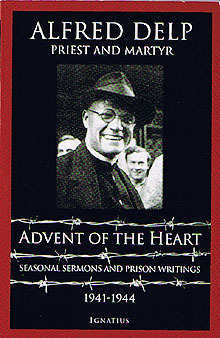 are so often festive in the cycle of the liturgical year. The Church stands before us with great gestures and great pomp and ceremonial rites. This is only an attempt to indicate something that reaches much deeper and must be taken much more seriously.
are so often festive in the cycle of the liturgical year. The Church stands before us with great gestures and great pomp and ceremonial rites. This is only an attempt to indicate something that reaches much deeper and must be taken much more seriously.
We need to celebrate holy days in three ways. First, by recalling a historical event. The feasts are always based on verifiable, historical facts. We should not just get carried away with unbridled enthusiasm. What is really going on? This is a question of discernment and recognition. Seen from God's perspective, there is always a clearly defined event connected to the mystery, a clear statement intended, a fact.
This brings us to the second point. Within all of the foregoing, a great mystery--the Mysterium--is hidden. Something happens between Heaven and earth that passes all understanding. This mystery is made present to us, continues in the world till the end of time, and is always in the process of happening--the abiding Mysterium.
These two points are followed by the third way in which we must consider the feast to be serious and important. Through the historical facts and through the workings of the mystery, the holy day simultaneously issues a challenge to each individual life, a message that demands a particular attitude and an interior decision from each person to whom it is proclaimed.
The Christmas celebration is the birth of the Lord. It is verifiable that Christ was born on this night. The great mystery behind this is the marriage covenant of God with mankind; that mankind is fulfilled only insofar as it has grown into this covenant. Concretely, it is meaningful to establish what this covenant, which began between divinity and humanity on that Holy Night, signifies as a challenge and message for each one of us.
In view of these preconditions, we want to read some passages from the Holy Scriptures about the mystery of Christmas--the three readings of the three Christmas Masses.
1. The Epistle for the Third Christmas Mass: "In many and various ways God spoke in times past to our fathers through the prophets; but in these last days He has spoken to us through a Son, whom He appointed the heir of the cosmos, through whom also He created the world. He reflects the glory of God and bears the very stamp of His nature, upholding the universe by His Word of power" (Heb 1:1-3). Basically, before moving on to personal devotions and contemplation or reading stories of the Holy Night, one should read these weighty verses of Saint Paul to be spiritually touched by the impact of this holy day we are celebrating. We Germans run the risk of concealing Christmas behind bourgeois customs and sentimenta1ity, behind all those traditions that make this holiday dear and precious to us. Yet perhaps the deep meaning is still hiding behind all those things. What this celebration is about is the founding of a final order for the world, a new center of meaning for all existence. We are not celebrating some children's holiday, but rather the fact that God has spoken His ultimate Word to the world. Christ is the ultimate Word of God to the world. One must let this idea really sink in these days when people are seeking new values. If you take God seriously--this relationship between God and the world--and if you know how important God is to society as well as to private life, then this has to touch you. The ultimate Word of God to the world! God does not contradict Himself and does not repeat Himself. One must use every ounce of willpower to comprehend this, and let this concept sink in: Christ, as the ultimate Word of God to the world.
And Christ came and placed Himself before us as a message. That He came as a child proves how much it matters to God that the message be accepted. From this Holy Night onward, the world has had the possibility of living in nearness to God or living apart from God. The entire Epistle wants to communicate one thing: take this, take what has happened here, really seriously. What came into the world is the very image of the Divine Being, is God Himself. He lifted mankind out of every false order in this consecrated night, in this blessed night. What is said to us here gives life its meaning, individual life as well as the life of all mankind.
The ultimate Word of God to mankind. This idea is expanded upon as follows:
2. The Epistle of the Second Mass of Christmas: "The goodness and kindness of God our Savior appeared; He saved us, not because of deeds done by us in righteousness, but by virtue of His own mercy" (Tit 3:4-7). The impact of these facts is further developed in two ways. What does this mean for man's inner reality, where he must come to an understanding of himself? And what does it mean for the fundamental attitudes toward life, the point at which the mystery becomes present and calls for a concrete response? To begin with the first question: What has happened to the measure of our being, through this Word that God has spoken into the world? The goodness and loving-kindness of God have appeared, so that we know and seriously must recognize ourselves as the substance of a divine commitment to man. Since then, God has taken no other position in relation to us than this "benignitas et humanitas [goodness and lovingkindness]". Because God's commitment upholds each and every one of us, even to the extent of His sharing in the very poorest and most helpless phase of human infancy, He has fully realized and made Himself accessible in the Incarnation. And now, in the background, our great, gruesome time stands up.
"Not because of deeds done by us in righteousness, but by virtue of His own mercy" (Tit 3 :5). The second tiling we need to know is that it is not because man is proud and worthy, but because God upholds us. Man needs to know that

we live from grace; we live from God's merciful commitment to mankind, from His mercy. Not as miserable wretches, however, but renewed in spirit; so that we know our intrinsic dignity, know that we are raised up above and beyond all else, because we mean so much to God. This is how we attain maturity in the presence of God.
3. Now--in the Epistle of the First Mass of Christmas--the effect of the foregoing is described. We will not be abused and violated, not even forced to be good or forced to love. We are challenged to do so, but it calls for a decision. The grace of God our Savior "teaches us to renounce godlessness and to live moral, upright, and pious lives in this world" (Tit 2:12). There are three great fundamental attitudes there, three great, foreign qualities of Christians in the world, three great commandments for perfection of life.
First [renouncing godlessness]: if the meaning of our lives is that God is really in covenant with mankind, then there can be no more godlessness--that would be loss of being--there is no more will to live. Godlessness is a calumniation of the divine life.
Second [regarding moral, upright, and godly living]: man should recognize that his innermost purpose is to find the way home to God and to be caught up in His life, to seek God for Himself. The fundamental concept of man in this world never can be that of certainty, but rather that of wait- ing for this ultimate revelation of that which began in the Holy Night. Such people, who know they are hastening to meet a great fulfillment, are always people under way.
Third [to become His own followers]: [1] these are people of loneliness, the people whom God wanted to have as His people, gripped by a great passion that God be well pleased, and ablaze with the divine fire that will be cast upon the earth.
And now, here is the last question: What does all of this mean today--the message of the great Kyrios, the Lord, the message of the fundamental attitude that the Holy Night demands? This is no Christmas life today. Neither is it a Christmas life according to people's inner attitude. Neither is it a Christmas holy day according to a religious perspective. The world is hostile and rejects everything. But we are experiencing the other side of Christmas. All of these blessings have already been taken away, and the night has descended again.
The first message is that the Kyrios, the Lord, is coming. The Lord does not stand in the center anymore. He is replaced by the power brokers. How man keeps lapsing into heresy! The power brokers, under whose power man has gone astray, stand in the center. One no longer sees God as the center of the world, as the foundational support. And what has developed out of this? We are standing without any foundation--we have nothing permanent anymore. There is no more talk of man's life being dependent upon mercy. Therefore the world has become so unmerciful. When has anyone taken away more from man than this? This is a time in which "apparuit benignitas et humanitas [the goodness and loving-kindness of God our Savior appearing]" is no longer acknowledged. What has become of man, that he does not want to be human in relation to God anymore? Beforehand, the Christmas words were sent packing. [2] This is a world in which it no longer can be said that "we await the great revelation of the Lord", a world that must cling to each day because it already knows that, in mere seconds, everything can be over. There is nothing left of peace and security. This is a world that no longer knows of the Holy Night, of the Consecration-Night, the Christ-Mass. [3] That is the one thing that we honestly have to see. The world in which we stand is un-Christmaslike, not because God is unmerciful, but rather because man has outlawed the message, and there is no room anymore for the promise.
Nevertheless, we must also look at this in a positive way. For us personally, this message of the Holy Night still does contain its great meaning and content. There are two things we need to have in terms of consciousness and attitude, and we should take possession of them today: we should not come to Midnight Mass as if we do not live in the year 1942. The year must be redeemed along with everything else. And from the Gloria, we have to take with us the peace and faith in the glory of God. There is nothing else that surpasses this night, and nothing that should be taken as more important than this event. Whatever may happen around us, let us not break down, for then we would not be taking the Lord seriously, or what we know about consecrated people seriously, or what we know about these messages. Therefore, deep down, we are the people who are comforted; and we are the last refuge for the homeless people who do not know anything about the Lord anymore. May we know about the indisputable fact of this Child and not let ourselves be disconcerted, not even by our own great un-freedom. "Apparuit benignitas et humanitas [the goodness and lovingkindness of God our Savior appearing]" (Tit 3:4). That should find its expression in the positive attitudes we take with us from this experience of the Holy Night. May we impart the goodness. May we attend to humanity again, and witness to the Lordship of God again, and know of His grace and mercy, and have gentle hands for other people again. And may we go away from Christmas Eve with the consolation that we mean so much to God that no external distress can rob us of this ultimate consolation. Our hearts must become strong, to make the divine heartbeat into the law of life again. God's readiness is established, but our gates are locked.
These should be the meaning of our wartime Christmas:
-- that we petition Him,
-- that He redeems us through the mystery,
-- that we are rich and capable enough through God's comfort to give mankind the comfort that it needs so much,
-- that we go away from this celebration as the great comforters, as the great knowers, the great blessed ones who know what it means to be consoled by God.
Endnotes:
[1] The context of Tit 2:12 clarifies Fr. Delp's point. The complete text, translated from the Latin, reads: "The grace of God our Savior has appeared to all mankind. It teaches us to renounce godlessness and the worldly passions, and to live sober, upright, and godly lives in this world. Meanwhile, we await, in blessed hope, the glorious coming of our great God and Savior, Jesus Christ, who gave Himself up for us to redeem us from all iniquity and to purify us so that we become His own: a people who are pleasing to Him, who follow in good works" (Tit 2:11-15). -- TRANS.
[2] References are to Nazi regulations restricting or forbidding Christian practice and customs. -- TRANS.
[3] The German word for Christmas is Weihnacht, but Fr. Deip wrote "WeiheNacht" (Consecration-Night). Compare "Meditation for the Fourth Sunday of Advent, 1944", note 13, p. ii. -- TRANS.
Related IgnatiusInsight.com Articles:
• Remembering Father Alfred Delp, S.J., Priest and Martyr | A Conversation with Father Karl Adolf Kreuser, S.J.
• Christmas: Sign of Contradiction, Season of Redemption | James V. Schall, S.J.
• "Hail, Full of Grace": Mary, the Mother of Believers | Joseph Cardinal Ratzinger
• "Conceived by the Holy Spirit, born of the Virgin Mary" | Hans Urs von Balthasar
• Archbishop Fulton Sheen on Advent and Eternity
• The God in the Cave | G.K. Chesterton
• Immaculate Mary, Matchless in Grace | John Saward
• "Conceived by the Holy Spirit, born of the Virgin Mary" | Hans Urs von Balthasar
 Alfred Delp: Priest and Martyr | Advent of the Heart
Alfred Delp: Priest and Martyr | Advent of the Heart
Seasonal Sermons and Prison Writings, 1941-1944
Fr. Alfred Delp was a German Jesuit priest who was imprisoned in Berlin. At the time of his arrest, he was the Rector of St. Georg Church in Munich, and had a reputation for being a gripping, dynamic preacher, and one who was an outspoken critic of the Nazi regime. He was an important figure in the Resistance movement against Nazism.
Accused of conspiring against the Nazi government, he was arrested in 1944, tortured, imprisoned, and executed on Feb 2, 1945. While in prison, Fr. Delp was able to write a few meditations found in this book, which also includes his powerful reflections from prison during the Advent season about the profound spiritual meaning and lessons of Advent, as well as his sermons he gave on the season of Advent at his parish in Munich. These meditations were smuggled out of Berlin and read by friends and parishioners of St. Georg in Munich.
His approach to Advent, the season that prepares us for Christmas, is what Fr. Delp called an "Advent of the heart." More than just preparing us for Christmas, it is a spiritual program, a way of life. He proclaimed that our personal, social and historical circumstances, even suffering, offer us entry into the true Advent, our personal journey toward a meeting and dialogue with God. Indeed, his own life, and great sufferings, illustrated the true Advent he preached and wrote about.
From his very prison cell he presented a timeless spiritual message, and in an extreme situation, his deep faith gave him the courage to draw closer to God, and to witness to the truth even at the cost of his own life. These meditations will challenge and inspire all Christians to embark upon that same spiritual journey toward union with God, a journey that will transform our lives.
"As one of the last witnesses who knew Fr. Alfred Delp personally, I am very pleased this book will make him better known in America. The more one reads his writings, the more one clearly recognizes the prophetic message for our times! Like his contemporary, Dietrich Bonhoeffer, Delp ranks among the great prophets who endured the horror of Nazism and handed down a powerful message for our times." -- Karl Kreuser, S.J., from the Foreword
Carl E. Olson's Blog
- Carl E. Olson's profile
- 20 followers


